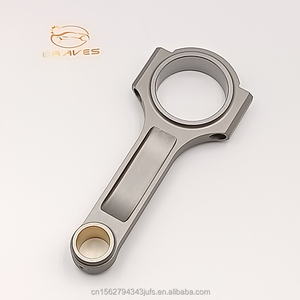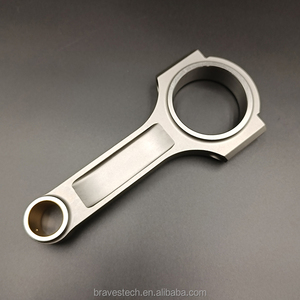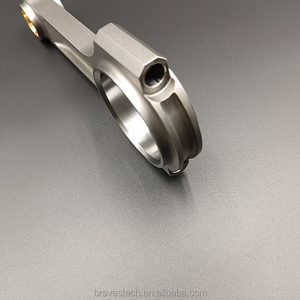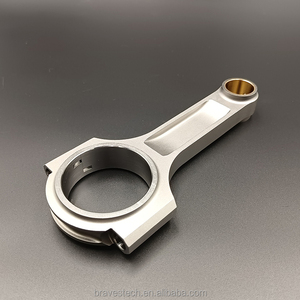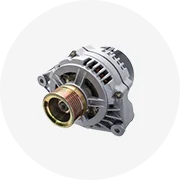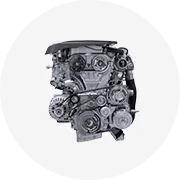Types of Forged Rods and Pistons
A vehicle's internal combustion engine relies heavily on precision-engineered components to deliver optimal performance, durability, and efficiency. Among the most critical parts are forged rods and pistons, which endure extreme mechanical stress and thermal conditions. These components are forged—rather than cast—for superior strength, fatigue resistance, and dimensional stability.
Forging involves shaping metal using localized compressive forces, often under high pressure, resulting in a denser grain structure that enhances material properties. This process makes forged rods and pistons ideal for high-performance engines, heavy-duty machinery, and motorsport applications where reliability and longevity are paramount.
Forged Pistons: Varieties and Applications
Forged pistons are designed to withstand intense heat and pressure while maintaining structural integrity. They are typically made from high-grade aluminum alloys or steel, depending on the application. Below are the main types of forged pistons:
-
Flat-Top Pistons
Characterized by their flat crown surface, these pistons are commonly used in diesel engines and low-compression gasoline engines. Their design allows for even flame propagation during combustion, leading to more efficient fuel burn and reduced emissions.
Pros
- Simple design with excellent manufacturability
- Promotes uniform combustion
- Cost-effective for standard applications
Cons
- Limited compression tuning flexibility
- Not ideal for high-horsepower builds
Best for: Commercial vehicles, basic gasoline engines, diesel applications
-
Dome-Shaped Pistons
The dome-shaped piston features a raised top that reduces chamber volume, thereby increasing the engine’s compression ratio. This design is popular in racing and performance-oriented engines where maximizing power output is crucial.
Pros
- Increases static compression ratio
- Enhances volumetric efficiency
- Ideal for forced-induction setups
Cons
- Requires precise valve clearance adjustments
- May increase risk of detonation
Best for: High-performance street cars, race engines, turbocharged/supercharged builds
-
Dish-Shaped Pistons
These pistons have a recessed top that effectively increases combustion chamber volume, lowering the compression ratio. They are particularly useful in rotary engines or applications where knock resistance is critical.
Pros
- Reduces compression ratio without altering head design
- Improves engine smoothness and reliability
- Suitable for large displacement engines
Cons
- Less effective in naturally aspirated high-output engines
- Can lead to slower combustion
Best for: Rotary engines, large V8s, emissions-focused designs
-
Forged Aluminum Pistons
Known for their high strength-to-weight ratio and thermal conductivity, forged aluminum pistons are widely used in performance and racing applications. They can withstand high RPM and extreme temperatures without deforming.
Pros
- Lightweight yet durable
- Excellent thermal expansion control
- High resistance to fatigue
Cons
- More expensive than cast alternatives
- Require tighter tolerances during installation
Best for: Motorsport, high-RPM engines, modified street vehicles
-
Forged Steel Crankshafts
While not technically a piston, crankshafts work directly with pistons and rods to convert linear motion into rotational energy. Forged steel crankshafts are used in high-load and high-torque environments due to their unmatched strength and longevity.
Pros
- Superior tensile strength
- Resists torsional flexing
- Long service life under heavy loads
Cons
- Heavier than cast iron or billet options
- Higher cost and machining complexity
Best for: Diesel engines, marine propulsion, industrial equipment, drag racing
Forged Connecting Rods: Types and Use Cases
Forged connecting rods link the pistons to the crankshaft and must endure tremendous reciprocating forces. The design and material selection significantly affect engine reliability and performance characteristics. Here are the major types:
-
H-Beam Rods
Named for their cross-sectional shape resembling an "H", these rods feature two wide flanges connected by a central web. This design provides exceptional rigidity and load distribution.
Pros
- Excellent bending and torsional stiffness
- Handles high cylinder pressures well
- Popular in automotive and motorsport builds
Cons
- Heavier than I-beam rods
- Less suitable for compact engine bays
Best for: High-horsepower street and track vehicles, diesel engines
-
I-Beam Rods
With a simpler I-shaped cross-section, these rods are lighter and easier to manufacture. They offer good strength-to-weight ratios and are commonly used in smaller engines where weight savings are important.
Pros
- Lightweight and compact
- Good balance between strength and weight
- Cheap to produce at scale
Cons
- Lower fatigue resistance compared to H-beam
- Not ideal for ultra-high-stress applications
Best for: Small-displacement engines, OEM applications, lightweight motorcycles
-
Sleeve Rods
Also known as "pin bushing" rods, these use a cylindrical sleeve to connect the small end (piston pin side) to the rod body. They are common in large industrial engines where robustness and ease of maintenance are key factors.
Pros
- Strong and reliable under heavy torque
- Easy to replace bushings for repairs
- Used in long-lasting industrial applications
Cons
- Bulkier and heavier than other rod types
- Complex assembly and alignment
Best for: Marine engines, construction equipment, stationary power units
-
Monoblock Rods
Machined from a single piece of forged material, monoblock rods eliminate joint interfaces, offering maximum structural integrity and minimal flex under load.
Pros
- Zero joints = less failure points
- Exceptional strength and fatigue resistance
- Used in Formula 1 and aerospace-grade engines
Cons
- Extremely expensive to produce
- Difficult to repair or modify
Best for: High-end motorsports, prototype engineering, specialized aerospace systems
-
Multi-Part Rods
Composed of multiple segments bolted together, these rods allow for adjustable length and weight configurations. They are especially useful in custom builds or experimental engines where fine-tuning is necessary.
Pros
- Customizable dimensions
- Allows for easy balancing and tuning
- Ideal for prototyping and research engines
Cons
- Increased complexity and potential weak points
- More expensive and time-consuming to assemble
Best for: Custom engine builds, dyno development, racing prototypes
| Type | Strength | Weight | Application Suitability | Cost Range |
|---|---|---|---|---|
| Flat-Top Piston | Medium | Medium | Diesel engines, standard gasoline | Low to Medium |
| Dome-Shaped Piston | High | Medium | Race engines, high-compression builds | Medium to High |
| Dish-Shaped Piston | Medium | Medium | Large engines, emissions compliance | Medium |
| Forged Aluminum Piston | Very High | Low | Performance and racing | High |
| Forged Steel Crankshaft | Very High | High | Industrial, marine, diesel | Very High |
| H-Beam Rod | Very High | High | Racing, high-horsepower | High |
| I-Beam Rod | Medium | Low | OEM, light performance | Medium |
| Sleeve Rod | High | High | Heavy-duty, industrial | High |
| Monoblock Rod | Very High | Medium | Formula 1, aerospace | Very High |
| Multi-Part Rod | High | Variable | Prototypes, custom builds | High |
Expert Tip: When selecting forged rods and pistons, always consider your engine's intended use, power goals, and operating conditions. For best results, match component materials and designs to ensure balanced performance and longevity. It's also wise to consult with a professional engine builder when designing high-output or custom builds.
Specifications and Maintenance of Forged Rods and Pistons
Key Specifications to Consider
Selecting the right forged rods and pistons is crucial for engine performance and reliability. The specifications must align with your engine's design, intended use, and power goals. Below are the most important factors to consider when choosing forged components:
Material Composition
Forged connecting rods are typically made from high-strength steel alloys like 4340 or 4130, which provide excellent fatigue resistance and durability under high stress. Titanium rods are also available for ultra-lightweight racing applications where weight savings are critical.
Pistons are commonly fabricated from aluminum alloys. 2618 alloy is preferred for high-performance engines due to its superior strength and thermal stability, while 4032 alloy offers better wear resistance and lower expansion rates, making it suitable for street and standard performance applications.
Connecting Rod Length
The length of a forged rod plays a significant role in engine geometry, affecting piston motion, combustion dynamics, and overall engine balance. Common lengths range from 5.5 inches for compact engines to over 7 inches for large displacement or long-stroke configurations.
Longer rods can reduce side loading on the cylinder walls, improve mechanical efficiency, and enhance engine longevity. However, they may require modifications to the crankshaft stroke or block deck height.
Piston Diameter (Bore Size)
Pistons come in a wide range of diameters to match the specific bore size of the engine cylinders. Standard sizes range from 70 mm for small-displacement engines up to 100 mm or more for large V8s and racing engines.
Custom applications often require precision machining in 1 mm or 0.5 mm increments to achieve optimal fitment and sealing within the cylinder bore after honing.
Piston Compression Height
This dimension refers to the distance from the centerline of the wrist pin to the top of the piston. It directly affects the compression ratio and piston placement within the cylinder head.
Standard compression heights typically range between 30 mm and 40 mm, depending on the piston profile and engine design. Performance applications may use custom compression heights to fine-tune combustion chamber volume and optimize airflow.
Big End Width and Bolt Size
The big end of the connecting rod connects to the crankshaft and must be precisely matched to the crank journal width and bolt pattern. Bolt sizes vary depending on application, with common sizes ranging from 7/16 inch for mild performance builds to 1/2 inch or larger for forced-induction or race engines.
Larger bolts increase clamping force and fatigue life, essential for high-RPM or high-horsepower setups.
Component Weight
Weight optimization is vital for rotating assembly balance and engine responsiveness. Forged rods typically weigh between 400 grams and 800 grams, depending on material and design, while performance pistons can weigh as little as 180 grams.
Lighter components reduce inertia, allowing for faster acceleration and smoother high-RPM operation. However, weight reduction must not compromise structural integrity or safety margins.
| Specification | Performance Impact | Recommendation |
|---|---|---|
| Rod Material | High | Use 4340 steel for high-load applications; titanium for extreme lightweight needs |
| Piston Alloy | High | Choose 2618 for track/race use; 4032 for daily drivers and boosted engines |
| Rod Ratio (Rod Length / Stroke) | Medium-High | Aim for ratios above 1.55 for improved piston alignment and reduced wear |
| Bolt Torque and Grade | High | Use ARP bolts rated at 170,000+ psi tensile strength and follow precise torque-to-yield specs |
Essential Maintenance Practices
Proper maintenance ensures the longevity and reliability of forged rods and pistons. Even high-quality components can fail prematurely without proper care and attention:
Important: Always replace connecting rod bearings and wrist pins when installing new rods or pistons. Mixing old and new components can create imbalance, improper clearances, and premature wear. Additionally, ensure all fasteners are torqued to specification using a calibrated torque wrench.
How to Choose Forged Rods and Pistons
Selecting the right forged rods and pistons is a critical decision for businesses involved in engine manufacturing, performance tuning, or heavy machinery maintenance. The quality and compatibility of these components directly affect engine efficiency, longevity, and reliability. Here's a comprehensive guide to help you make informed decisions when selecting forged rods and pistons.
Application Requirements
The intended application plays a pivotal role in determining the type of forged rods and pistons required. Different applications demand specific engineering considerations to ensure optimal performance under expected conditions.
- Racing Engines: Require high-strength alloys and lightweight designs to withstand extreme RPM and thermal stress
- Commercial Vehicles: Prioritize durability, fuel efficiency, and load-bearing capacity over outright performance
- Industrial Machinery: Need robust construction to endure continuous operation and variable loads
Key consideration: Always match component specifications with the operational demands of the equipment
Engine Compatibility
Forged rods and pistons must be precisely engineered to work seamlessly with other engine components. Proper fitment ensures smooth operation and prevents premature wear or failure.
- Check rod length against crankshaft stroke and deck height
- Verify piston compression height matches engine block dimensions
- Ensure wrist pin diameter aligns with connecting rod small end bore
- Confirm valve pocket depth accommodates cylinder head design
Measurement tip: Use precision measuring tools (micrometers, calipers) for critical dimensions
Material Quality and Certification
High-quality forged components are manufactured using aerospace-grade alloys and undergo rigorous testing to meet industry standards such as SAE, ISO, and ASTM specifications.
- Common materials include 4340 chromoly steel for rods and 2618 aluminum alloy for pistons
- Quality indicators: Tensile strength ratings, fatigue resistance data, and microstructure analysis
- Certifications: Look for components that meet or exceed OEM specifications
Testing importance: Certified components reduce failure risk by up to 70% compared to non-certified alternatives
Customization Options
Custom forged components can be tailored to meet specific performance requirements, offering advantages in weight optimization, strength characteristics, and specialized coatings.
- Weight reduction through precision machining without compromising structural integrity
- Compression ratio adjustments for forced induction or naturally aspirated applications
- Surface treatments like anodizing, shot peening, or nitriding for enhanced durability
- Coatings such as DLC (Diamond-Like Carbon) to reduce friction and improve heat resistance
Performance benefit: Custom solutions can improve horsepower output by 5-15% while maintaining reliability
Budget Consideration Tip: While initial cost is important, consider the total cost of ownership. Premium forged components may have higher upfront costs but often provide better long-term value through extended service life, reduced maintenance, and improved fuel efficiency. Calculate potential savings from reduced downtime and lower replacement frequency before making a final decision.
| Application Type | Recommended Material | Typical Cost Range | Expected Service Life |
|---|---|---|---|
| Street Performance | 4340 Chromoly Steel Rods / 2618 Aluminum Pistons | $800 - $1,500/set | 100,000+ miles with proper maintenance |
| Diesel Truck Applications | 300M Alloy Steel Rods / Forged Steel Top Ring Land Pistons | $1,200 - $2,500/set | 300,000+ miles |
| Race Engines | Titanium Rods / High-Silicon Aluminum Pistons | $2,500 - $5,000/set | Varies based on racing intensity |
| Industrial Equipment | SAE 4330 Modified Steel Rods / Cast Iron Piston Heads | $1,800 - $3,500/set | Extended life cycles with scheduled replacements |
Selection Advice: When choosing between similar options, prioritize suppliers who offer technical support and detailed documentation about their manufacturing processes, material sources, and quality control procedures. This information helps verify the actual performance capabilities of the components beyond basic marketing claims.
How to DIY and Replace Forged Rods and Pistons
Replacing forged steel connecting rods and pistons is a significant mechanical task that requires technical knowledge, precision tools, and careful execution. This upgrade is often performed to enhance engine durability and performance, especially in high-performance or modified engines. Whether you're rebuilding an engine after wear or upgrading for more power, this comprehensive guide will walk you through the process safely and effectively.
Safety Warning: Engine disassembly involves sharp tools, heavy components, and potentially hazardous materials. Always wear safety glasses, gloves, and work in a clean, well-lit space with proper ventilation.
Essential Tools and Materials
Before beginning the replacement, ensure you have all necessary tools and materials ready. Having everything on hand will streamline the process and prevent interruptions.
- Socket and ratchet set – for removing bolts and fasteners of various sizes
- Torque wrench – critical for tightening bolts to manufacturer specifications
- Allen key set – for hex bolts commonly used in rod caps
- Timing tool kit – to properly lock camshafts and crankshaft during timing belt removal
- New forged connecting rods and pistons – matched to your engine's specifications
- Engine oil – for refilling and initial lubrication
- Cleaning solvent – for degreasing parts before reassembly
- Gasket scraper and new gaskets – especially for cylinder head and valve cover
- Feeler gauge and micrometer – for checking clearances if needed
- Shop manual or repair guide – specific to your vehicle model and engine type
| Component | Recommended Tool | Alternative Options | Purpose |
|---|---|---|---|
| Rod Bolts | Allen Key Set | Hex Bit Socket | Removing and installing rod caps |
| Cylinder Head | Socket and Ratchet Set | Breaker Bar | Loosening and tightening head bolts |
| Timing Belt | Timing Tool Kit | Manual Crank Locking Tool | Maintaining correct timing alignment |
| Fasteners | Torque Wrench | Digital Torque Adapter | Ensuring precise torque specs are met |
Detailed Step-by-Step Replacement Guide
- Prepare the Engine and Workspace
- Park the vehicle on a level surface and engage the parking brake.
- Allow the engine to cool completely to avoid burns from hot components.
- Disconnect the battery’s negative terminal to prevent electrical shorts.
- Drain the engine oil and coolant into appropriate containers for safe disposal or reuse.
- Ensure your workspace has good lighting, ventilation, and enough room to organize parts and tools.
- Remove the Engine Cover and Spark Plugs
- Use a socket set to remove the bolts securing the engine cover or valve cover.
- Lift off the cover carefully and set it aside, ensuring not to damage any gaskets or sensors.
- Remove each spark plug using a spark plug socket to reduce the risk of damaging the ceramic insulator.
- Drain the Engine Coolant System
- Locate the lower radiator hose connected to the engine block.
- Use pliers or a screwdriver to loosen the hose clamp and slide it down the hose.
- Disconnect the hose and allow the coolant to drain into a container for proper disposal or recycling.
- Remove the Timing Belt
- Access the timing belt by removing any protective covers or pulleys blocking access.
- Use a timing tool to lock the camshaft and crankshaft in place to maintain timing alignment.
- Loosen the tensioner bolt and carefully remove the timing belt from the sprockets.
- Label or mark the position of the belt and sprockets for easier reinstallation later.
- Remove the Cylinder Head
- Use a socket set to remove the cylinder head bolts in the sequence specified by the manufacturer (usually from the outer edges inward).
- Lift the cylinder head off the engine block slowly, being cautious of any stuck gaskets.
- Inspect the head and block surfaces for warping or damage before proceeding.
- Extract Old Rods and Pistons
- With the cylinder head removed, locate the connecting rods attached to the crankshaft.
- Use an Allen key set to loosen and remove the rod cap bolts.
- Slide the rod and piston assembly out of the cylinder bore carefully to avoid scratching the walls.
- Repeat this process for each piston and rod pair, keeping track of which rod belongs to which cylinder.
- Clean Engine Components
- Use a cleaning solvent and soft brushes to clean carbon deposits from the engine block and cylinder walls.
- Wipe down the crankshaft journals and check for scoring or wear.
- Clean the inside of the cylinder head thoroughly before reinstallation.
- Install New Forged Rods and Pistons
- Apply a thin layer of clean engine oil to the piston rings and cylinder walls to aid installation.
- Insert each new piston and rod assembly into the corresponding cylinder bore.
- Secure the rod cap to the crankshaft using the Allen key set and tighten to the manufacturer's torque specification.
- Double-check the orientation and clearance of each rod and piston to ensure smooth movement without binding.
- Reassemble the Engine Components
- Reinstall the cylinder head following the reverse order of removal, torquing the bolts in the correct sequence.
- Replace the timing belt using the markings made earlier to align the camshaft and crankshaft correctly.
- Reattach the spark plugs and engine cover, ensuring all connections are secure.
- Refill Fluids and Reconnect Battery
- Refill the engine with the recommended grade and amount of motor oil.
- Refill the cooling system with the appropriate coolant mixture as specified in your service manual.
- Reconnect the battery and double-check all fluid levels before starting the engine.
- Initial Start-Up and Inspection
- Start the engine and listen for unusual noises such as knocking or ticking, which may indicate improper installation.
- Check for oil or coolant leaks around the cylinder head, timing cover, and other connection points.
- Let the engine idle for several minutes to circulate fluids and monitor temperature and pressure readings.
- Follow the break-in procedure for forged components if provided by the manufacturer, which may include avoiding full throttle operation initially.
DIY Tip: Label each rod and piston assembly as you remove them to ensure they go back into the same cylinder. This helps maintain proper balance and prevents engine vibration issues.
Why Upgrade to Forged Rods and Pistons?
Forged rods and pistons offer superior strength and heat resistance compared to cast or hypereutectic alternatives. They are ideal for engines subjected to higher compression ratios, forced induction (turbo/supercharger), or increased horsepower applications. While more expensive, these components can significantly extend engine life and reliability under demanding conditions.
Note: If you're unsure about any step in this process, especially related to timing alignment or torque specifications, consult a professional mechanic or refer closely to the factory service manual.
Frequently Asked Questions About Piston Rods and Pistons
Piston rods require consistent and thorough maintenance to ensure optimal engine performance and longevity. The key maintenance practices include:
- Regular Inspection: Check for signs of wear, cracks, or bending during scheduled maintenance intervals. Any deviation from factory specifications can lead to engine failure.
- Cleaning: Remove dirt, debris, and carbon buildup that may accumulate on rod surfaces and bearings. Use appropriate degreasers and brushes to maintain cleanliness without damaging components.
- Lubrication: Apply high-quality engine oil or specialized lubricants to reduce friction between moving parts. Proper lubrication minimizes wear and prevents overheating.
- Alignment and Installation: Ensure rods are properly aligned and installed according to manufacturer guidelines. Misalignment can cause uneven stress distribution and premature failure.
Failure to maintain piston rods can result in costly repairs or catastrophic engine damage, especially under high-stress conditions such as racing or heavy-duty applications.
Forged and non-forged (typically cast) piston rods vary significantly in terms of strength, durability, and application suitability:
- Forged Rods: These are formed using high-pressure forging techniques that align the metal grain structure, enhancing mechanical properties. Forged rods offer:
- Superior tensile and fatigue strength
- Better resistance to high temperatures and stress
- Greater reliability in performance-oriented engines
- Non-Forged Rods: Usually manufactured via casting or machining processes. They tend to have a more isotropic microstructure, which makes them less durable under extreme conditions. These rods are typically:
- More cost-effective for standard applications
- Suitable for low-to-moderate horsepower engines
- Less forgiving in high-performance or racing environments
In general, forged rods are preferred for engines that demand higher output, while non-forged rods are adequate for everyday commuter vehicles or light machinery.
Using forged rods and pistons provides several distinct advantages that contribute to enhanced engine performance and reliability:
- Increased Strength: Both forged rods and pistons are engineered to withstand greater mechanical loads and thermal stresses compared to their cast counterparts.
- Improved Durability: The refined grain structure from the forging process increases fatigue resistance, extending component life even under harsh operating conditions.
- Weight Optimization: Modern forged components are designed to be lightweight without sacrificing structural integrity, which contributes to better acceleration and fuel efficiency.
- Higher Performance Potential: Forged components allow for increased compression ratios and turbocharging/supercharging without compromising reliability, making them ideal for modified or racing engines.
- Cost Efficiency Over Time: While initially more expensive, the extended service life and reduced need for replacements make forged rods and pistons more economical in the long run.
These benefits make forged rods and pistons a popular choice among enthusiasts and professionals looking to maximize engine output and reliability.
The rod and piston form a critical linkage within the internal combustion engine, playing a central role in converting chemical energy into mechanical work:
- Combustion Force Transmission: When the air-fuel mixture ignites, the resulting pressure forces the piston downward. This motion is transferred through the connecting rod to the crankshaft, where it is converted into rotational energy.
- Reciprocating Motion Control: The synchronized movement of the piston and rod ensures smooth operation by maintaining precise timing with the crankshaft and valves, preventing mechanical interference.
- Load Distribution: High-quality rods and pistons help distribute dynamic loads evenly across the engine components, reducing stress concentrations and prolonging engine life.
- Thermal Management: Properly designed rods and pistons help manage heat generated during combustion, ensuring the engine operates within safe temperature limits.
Without efficient rod and piston systems, engines would not be able to generate usable power effectively or reliably, underscoring their foundational importance in automotive and industrial engineering.
While both forged and billet piston rods are known for their strength and quality, they differ significantly in manufacturing method, performance characteristics, and cost:
| Feature | Forged Rod | Billet Rod |
|---|---|---|
| Manufacturing Process | Shaped using high-pressure dies | Machined from a solid block of metal |
| Grain Structure | Dense, aligned grain improves strength and fatigue resistance | Uniform but isotropic grain structure |
| Strength | Excellent for most high-performance applications | Can be slightly stronger depending on alloy and design |
| Customization | Limited to die designs | Highly customizable for unique applications |
| Weight | Generally lighter due to optimized design | May be heavier due to material removal during machining |
| Cost | More affordable than billet | More expensive due to labor-intensive machining |
In summary, forged rods provide excellent value and performance for most applications, while billet rods are often chosen when customization, specific design needs, or ultra-high-strength requirements justify the added expense.















